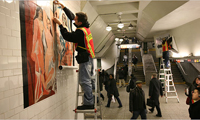
Photographs by Chester Higgins Jr./The New York Times
By RANDY KENNEDY | Published: February 9, 2009
MoMA Brooklyn: Workers mounting reproductions of pieces from the permanent collection in connecting subway stations.
The Metropolitan Transportation Authority and its advertising contractors routinely review the content of subway ads, keeping their eyes out for things that are too racy or rude. But they have never had an ad quite like one that came their way recently: an image of five naked women (probably prostitutes) vamping it up and staring down the viewer.
Coming to grips with the Museum of Modern Art, or at least an advertisement for it.
The fact that the frontal nudity is fully Cubist and was painted by Picasso more than a century ago undoubtedly made the decision a lot easier. And so on Monday, a glossy reproduction of that artwork, “Les Demoiselles d’Avignon,” took its place underground in the Atlantic Avenue and Pacific Street subway stations in Brooklyn, with copies of 57 other works from the Museum of Modern Art that will briefly transform the cavernous stations into a kunsthalle.
The museum’s publicity campaign, one of the most ambitious it has ever undertaken in the city, will cover every ad space in the two connected stations, spaces normally given over to plugs for movies, beer and podiatry treatments. In their place will be reproductions of works drawn from all parts of the museum, both well-known and more contemporary, by artists like Matisse, Hopper, O’Keeffe, Marlene Dumas, Cindy Sherman and Martin Kippenberger.
“We’ve never done a large-scale ad campaign for New Yorkers focused just on the permanent collection,” said Kim Mitchell, the museum’s chief communications officer. She said the idea had grown out of a new marketing advisory committee’s feeling — confirmed by focus groups — that many New Yorkers view the museum as a tourist-saturated place that is no longer quite as welcoming to natives.
“The whole city is important to MoMA, and this station just seemed to be a good place to start the experiment,” Ms. Mitchell said in an interview near the stations, among the city’s busiest, used by 50,000 commuters a day.
The six-week campaign, intended not only to draw more New Yorkers to the museum but also to encourage them to buy museum memberships, is what the M.T.A. calls, with slight Orwellian overtones, a “station domination.”
Aside from the billboard spaces, the stations scream MoMA from the columns, the tiled walls and even the arms of the turnstiles, many of them covered with shrink-wrap-like material emblazoned with the museum’s name.
The reproductions of the works, however, are presented just as the works are in the museum, unadorned except for explanatory labels alongside them that look just like the real ones. (A few of the works even have audio guides, which can be heard on the stations’ pay phones or downloaded to portable devices.)
Some of the works — like a still from Doug Aitken’s video “sleepwalkers” — will probably resonate with weary morning commuters more than others. But after a few weeks of seeing culture dominate commerce, subway riders might like it enough to argue with a copy of Allen Ruppersberg’s playful poster, which says, “It’s Not Art (That Counts Now).”
 Photographs by Chester Higgins Jr./The New York Times
Photographs by Chester Higgins Jr./The New York Times